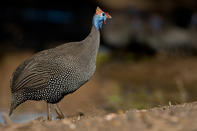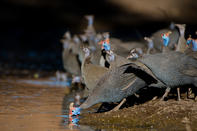
Name
Helmeted Guineafowl - Numida meleagrisHelmeted Guineafowl Appearance
The helmeted guineafowl is the largest of the guineafowl in South Africa, at 56 cm in length. This guineafowl has a black to grey plumage with striking white spots. This bird has a bald face and neck, that is blue in colour, with red wattles. A bony casque, yellow to brown in colour, is found on the top of the head.Both male and female are alike in appearance, but with the male having longer wattles.
Helmeted Guineafowl Diet

Helmeted Guineafowl Breeding
The helmeted guineafowl is monogamous. The males fight aggressively for the right to mate with a female. The nest is a shallow scrape, well hidden in thick vegetation, normally on the forest verge. The hen lays 7 to 12 eggs and they are incubated for around 23 days.
The eggs are incubated by the female, with the male returning to the nest when the chicks hatch, to assist with brooding and rearing of the chicks. The chicks are highly precocial and are able to leave the nest almost immediately and start foraging for themselves. They start to fly short distances after a week.
Helmeted Guineafowl Behaviour
The helmeted guineafowl will often practise intra-specific brood-parasitism. The behaviour of one female laying her eggs in another nest of the same species, then abandoning the eggs for them to be incubated by the female whose nest was used.
Over 40 eggs have been recorded in a single nest. Helmeted guineafowls are a gregarious species and form flocks of around 25 birds, outside of the breeding season. Groups of 200 birds have been recorded.
The helmeted guineafowl will roost in a tree at night, to avoid predation. They have a strong, fast, but not sustainable, flight, used to avoid predators. They can fly up to 100 m before needing to land. The helmeted guineafowl will run before flying when in danger.
The males are dominant and differences are settled by a form of endurance. The males will chase each other around on the ground, with the winner having the better stamina.
Threats
None, of least concern.Guineafowl can be a problem for farmers as they will damage and eat emerging seedlings of agricultural crops.